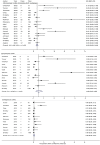A systematic review and meta-analysis on the prevalence of non-malignant, organic gastrointestinal disorders misdiagnosed as irritable bowel syndrome
- PMID: 35121775
- PMCID: PMC8817019
- DOI: 10.1038/s41598-022-05933-1
A systematic review and meta-analysis on the prevalence of non-malignant, organic gastrointestinal disorders misdiagnosed as irritable bowel syndrome
Abstract
Treatable gastrointestinal disorders in patients with symptoms typical for irritable bowel syndrome (IBS) may be overlooked. The prevalence of five gastrointestinal conditions-bile acid diarrhoea (BAD), carbohydrate malabsorption (CM), microscopic colitis (MC), pancreatic exocrine insufficiency (PEI) and small intestinal bacterial overgrowth (SIBO) was systematically assessed from studies including consecutive patients meeting diagnostic criteria for IBS. 4 databases were searched from 1978 to 2020. Studies were included if they evaluated the prevalence of these conditions in secondary healthcare setting. Estimated pooled rates were calculated and statistical heterogeneity between studies was evaluated using Q and I2 statistics. Seven studies (n = 597) estimated the pooled prevalence for BAD as 41% (95% CI 29-54). 17 studies (n = 5068) estimated that of MC as 3% (95% CI 2-4%). Two studies (n = 478) suggested a rate of 4.6% (range: 1.8-6.1%) for PEI. Using breath testing, 26 studies (n = 6700) and 13 studies (n = 3415) estimated the prevalence of lactose and fructose malabsorption as 54% (95% CI 44-64%) and 43% (95% CI 23-62%); 36 studies (n = 4630) and 22 studies (n = 2149) estimated that of SIBO as 49% (95% CI 40-57%) with lactulose and 19% (95% CI 13-27%) with glucose. Rates of all conditions were significantly higher than in healthy controls. A significant proportion of patients presenting to secondary care with IBS have an organic condition which may account for their symptoms. Failure to exclude such conditions will deny patients effective treatment.
© 2022. The Author(s).
Conflict of interest statement
The authors declare no competing interests.
Figures







References
-
- Mearin F, et al. Bowel disorders. Gastroenterology. 2016;130:1480–1491. - PubMed
Publication types
MeSH terms
Substances
LinkOut - more resources
Full Text Sources
Research Materials

